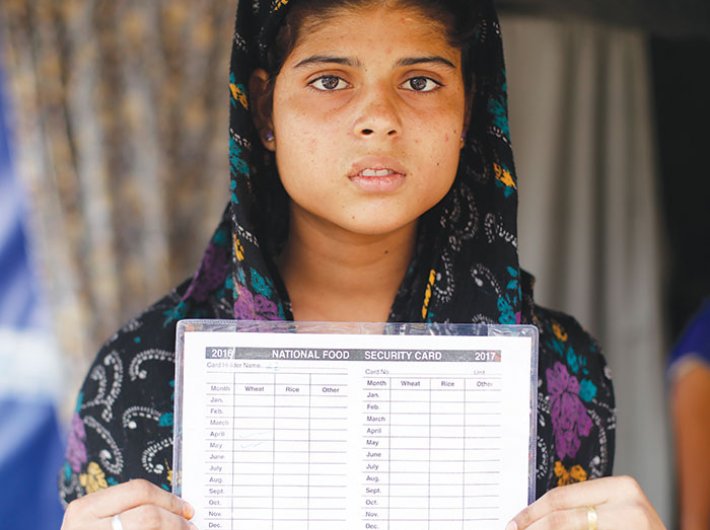An ambitious food security law that vows to ensure that the poor don’t go hungry is languishing, with some states not even completely identifying the beneficiaries
The stench is unbearable in the dingy lanes of Sanjay Colony of Okhla, south Delhi, where sunlight barely seeps in. An overflooded drain running along the lanes adds to the distressing picture. The place is just like any other slum colony and is home to more than 7,000 people who earn their livelihood through ‘katran’ (cloth work) or as daily labourers.
Under such grim conditions, they can barely eke out a living. In such a situation, having a ration card makes all the difference as those who have the document at least don’t go to bed hungry, while others are likely to. A ration card ensures access to subsidised food grains at fair price shops while the others depend on the open market for their food needs.
The National Food Security Act (NFSA) hopes to address this lacuna. It assures food security for nearly two-thirds of India’s over 120-crore people. But the way it is implemented leaves much to be desired. For example, authorities are yet to ensure that all the poor are identified and then food grain is disbursed to them.
The case of 40-year-old Manoj, who earns only '150 per day from daily labour and survives on widow pension, highlights the plight of those who don’t have a ration card. “Officials ask for so many documents as address proof like the electricity bill, but it is difficult for a family like us to get them since we don’t have electricity connection. Even the Aadhaar card from our native state of Bihar is not being accepted [as address proof] to get a ration card,” said the mother of six children.
Shabnam, a 21-year-old woman who assists her mother in katran work, complains that she has got a ration card that does not have the names of all her family members. She is the second-eldest child and has six siblings, in a family of nine. “Yes, we are nine but as per our ration card we are a family of only seven people,” says Shabnam.
Her family is a registered beneficiary under NFSA in which each family member is entitled to receive 5 kg of food grain in a month. But, Shabnam says her family gets only 24 kg of wheat and six kg of rice at subsidised rates, which means she is availing food for only six people.
She has been desperately trying to get the two missing names added to the ration card. “But no one is ready to listen,” says Shabnam. She shows the ration card. There is no mention of the quantity of wheat and rice provided to her family in the ration entries.
Both Manoj and Shabnam are struggling for their basic rights. They are among the 50 percent urban population that needs to be covered under NFSA. The law also has provision for covering 75 percent rural households.
The UPA government introduced the bill in December 2011, but it was in such tearing hurry to implement the Right to Food that in 2013 it took the ordinance route. The hurry, however, ended there, and even three years later the states are struggling at the incipient phase of identifying the beneficiaries.
Proper identification of priority households, as mentioned in the Act, is crucial to prepare a list of those to be included and those to be excluded. However, identification has not been carried out in a systematic and scientific method, says the Comptroller and Auditor General (CAG) report on the implementation of NFSA that was tabled on April 29.
When secretaries from different states gathered in the national capital in April for the National Human Rights Commission’s (NHRC’s) two-day conference on Right to Food, facts similar to what the CAG report highlighted kept on resurfacing.
Across the country, until 2015, only 51 percent of the eligible beneficiaries have been identified whereas the remaining 49 percent are yet to be identified. Several states have re-stamped the old ration cards as NFSA compliant. Undoubtedly, the revision of the list was looked as a dynamic and continuous process while framing the Act.
Vrinda Swarup, secretary, department of food and public distribution, union consumer affairs ministry, acknowledged the current state of affairs at the NHRC conference. She noted it would be incorrect to say that selection or inclusion was perfect across states. “Since it’s a state-centric exercise, it took time for the states to implement NFSA as ineligible households were to be weeded out through the exercise at the ground level.”
The CAG report says that states like Maharashtra, Bihar, Himachal Pradesh and Assam did not carry out fresh identification exercise and went ahead with the existing Antyodaya Anna Yojana (AAY) and below poverty line (BPL) card holders.
Several states framed the guidelines for identification as per the Act, but did not carry out fresh exercise for priority households or verification of beneficiaries under AAY. It is because of the breathing time given to states under NFSA that does not bar them from implementing the Act even with incomplete identification of beneficiaries. The states continue to receive allocation under the existing targeted public distribution system (PDS), till the selection process is complete.
In some cases this leads to the problem of plenty too. Karnataka did not frame any guidelines to identify households. It instead included the existing 403.25 lakh BPL families against required 359.81 lakh (the upper limit), thus giving the benefits of NFSA to additional 43.44 lakh beneficiaries from its own resources. As per the CAG report, 8.90 lakh bogus and ineligible ration cards were traced in the system. Instead of cancelling those bogus cards, the state government continues to allocate food grain to them.
“There are several hard-to-reach groups such as the homeless, people living in inaccessible areas, migrants, and beggars. States should conduct surveys to make food reach to people who need it, instead of providing ration to bogus card holders,” says Suman of NGO Food First Information and Action Network (FIAN).
“Vulnerable population should be on the priority household list. They complain of non-issuance of ration cards as they can’t avail benefits under the PDS,” she adds.
In such a scenario, the Socio Economic Caste Census (SECC) could have been a basic tool in the identification process. The centre indicated taking SECC into consideration as the ministry of rural development started the survey in 2011. However, the survey was not completed till 2013 and was finalised last year.
States like Gujarat and Uttar Pradesh and union territories like Andaman and Nicobar Islands cited it as the reason for the delay. On the other hand, going by the CAG report, the centre did not try to resolve the issues faced by the states in identification. Instead, it extended the time limit of 365 days laid down in the NFSA thrice, though the Act has no such provision for extension. Until last year, the deadline was July 2014. Now, 33 states and union territories have implemented it.
States like Odisha, Gujarat, Jharkhand and Madhya Pradesh are trying to incorporate more beneficiaries by having their separate data collection procedure and taking SECC as the basic tool.
Experts call for regular consultation between the centre and the states regarding the identification of the needy. “The Act is in a diluted state,” says Right to Food activist Harsh Mander. “Since the Act came during the last stages of the UPA tenure, certain loopholes were not covered. It is now the duty of the current government to look into the basic parameters.”
Some experts, however, believe that uniformity among states in the process to identify households cannot be achieved. “In the Act, a methodology has been set on the basis of which people have to be included in AAY and priority household. But the onus is on the state government to finalise the list. It is the state machinery that works at the district and therefore plays a crucial role,” says NC Saxena, member of the National Advisory Council of the UPA regime and former secretary, rural development.
Saxena, who also assists the supreme court as commissioner in the Right to Food matters, says, “There should be monitoring on whether legalities are being followed or not. Though states have reported implementing the Act, there is no survey or monitoring on the process or the figures provided by the states to the centre. The inclusion and exclusion criteria become crucial as in the earlier lists of beneficiaries there were too many ghost ration cards.”
So, how does one maximise the NFSA coverage?
Poverty has to be looked from two different aspects – first how many poor are there and second who are these poor? Perhaps the answers to these questions can be of immense help in making the selection.
According to the NSSO data, on the basis of consumption of food grain the bottom 30 percent of the population is poor. But who are those people is decided by the respective state governments. They could be SC/ST, migrant workers and households where women earn the income. Therefore, identification of the deprived becomes crucial.
It cannot be denied that it can vary from state to state as per the socio-economic condition. But the centre needs to have a complete record of the number of people who are ‘food insecure’.
Notably, migrants form a significant category which is not getting access to food grain under the PDS. A third of the population of 1.21 billion are migrants. A ration card is compulsory under NFSA to receive subsidised food. But migrants carrying ration cards of their native place cannot avail the benefit. On the other hand, many migrants who have been living in a place for several years find it difficult to apply for a ration card as they usually do not have any proof of residence at that place.
NFSA’s three basic As
Is NFSA able to fulfill the three basic As – availability, access and absorption?
Saxena says that India is in the category of severe hunger. Calorie consumption for rural should be 2,400 per day and for urban at 2,100. But in 50 percent of the rural areas, consumption is less than 1,900 calories. A concern has been expressed over the bumper export of food grain. “The policy regarding the export of cereals should be revisited,” says a worried Saxena.
Referring to the central government’s Economic Survey 2014-15, he says, “The food grain production in India has gone down since 2013, the year of bumper production. On the other hand, the country has been exporting large quantities of food grain causing the availability to decline.”
Perhaps, this imbalance has been affecting the open market price. Therefore, the bottom 30 percent of the population, who are actual poor and are somehow dependent on the open market, have less cereal intake.
“It is highly unethical to export food grain when our own people are suffering from starvation. This will lead to hunger and malnutrition,” he says and adds, “For example, if basmati is to be exported, equal amount of ordinary rice or pulses must be imported.”
Second, access can only be improved if we have good PDS without any leakages. And third, absorption of nutrient is only possible when there is enough awareness about sanitation and hand -wash programmes.
HL Dattu, former chief justice of India and chairperson of NHRC, says there is a need to bring in changes at the public policy level to address the food security issue. There should be short-term as well as long-term strategies which would need involvement of other ministries.
archana@governancenow.com
(This article appears in the May 16-31, 2016 issue of Governance Now)

